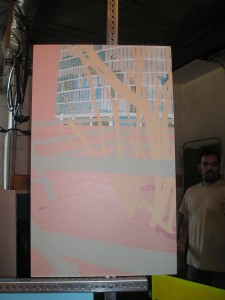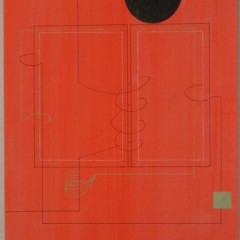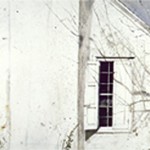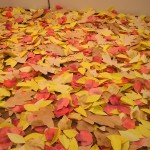Mauro Zamora has been working hard to get ready for the September 19 opening of his exhibition at Wave Hill in the Bronx, and he recently let me visit his studio for a sneak peak at what he’s been preparing. Wave Hill is a 28-acre public garden and cultural institution that overlooks the Hudson River. Its manicured gardens and breathtaking landscape are the perfect foil for Zamora’s paintings that are all about nature’s impulse to thrive despite human-made restrictions.
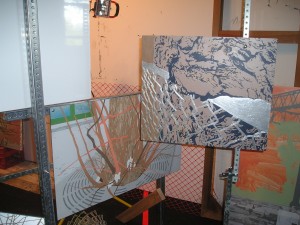
Zamora has been working successfully in Philadelphia since he received his MFA from the Pennsylvania Academy of the Fine Arts in 2004. His work was included in the 2005 Fleisher Challenge exhibition and in 2008 he won a Pew Fellowship in the Arts. He produced the 14 paintings for this show at Wave Hill during a summer residency at the Millay Colony for the Arts. A large wall drawing, still in the works, will also be included. Most of the paintings for Wave Hill will be displayed on an intricate structure/sculpture that Zamora made out of municipal signposts. Other materials such as bright orange flexible fencing, tape, and chain link fence will also be part of the installation. The finished structure suggests a construction site and the paintings, bolted or tied onto this structure, are the associated signage. For all of these works, Zamora used only municipal and industrial materials he found at a supply store near King of Prussia. The large wall drawing is on Tyvek and the paintings are on aluminum.

The gallery at Wave Hill is about 17 feet square with lots of windows, which posed a challenge for Zamora who makes paintings that typically hang on walls. The signpost structure allowed him to explore some themes he was interested in – specifically what happens to nature when left unattended on a construction site – and to find ways to exhibit paintings in the center of a room. Other large paintings will lean up again a wall. The back of one of them is painted with a bright, florescent yellow pigment that will glow against the wall and create a colored halo around the work. For Zamora, “The physical challenge of the gallery at Wave Hill is exciting.”
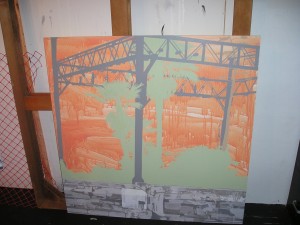
The surfaces of Zamora’s paintings are always interesting because it is hard to tell exactly how they are made. Most of them include a mix of water-based paints, inks, and pigments, which, he mentions, “has taken me years to figure out.” And, in what seems a typical strategy for painters today, Zamora brings all tools to bear in the choosing of his subject matter and compositions. Typically, he uses found photos on the web or pictures he has taken himself for the subject, manipulates it all in Photoshop, and then projects imagery onto a surface and paints it in.
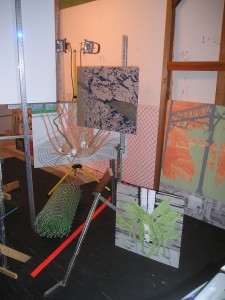
Many of Zamora’s signature themes are found in this work for Wave Hill — fences, borders, human transgressions on nature and vice versa. The fences reference “geo-political issues” and started appearing in Zamora’s work around the time that the Bush administration proposed a fence between the United States and Mexico. The fences may be metaphor for issues about inclusion, exclusion, and power. These ideas will be reinforced by the way that visitors will be made to walk around the large signpost structure/sculpture in order to get a view of the paintings; in some positions only the backs of the paintings can be seen.
Ideas about nature’s peril and resiliency loom large in these paintings. Is a tree growing around a chain link fence a hopeful statement about nature’s elasticity despite the threats posed by society? Zamora doesn’t take a stance exactly, saying instead that for him the paintings have to do with finding beauty in the “visual aspects of decay.” This idea is an interesting contrast to the setting of Wave Hill, a place that maintains all the ideals of a manicured pleasure garden. It’s as though Zamora will be importing into this Arcadia an abandoned Philadelphia construction site, and forcing a question that has been driving his work: “what else can landscape painting be?”


